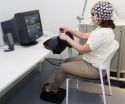(Press-News.org) Scientists have discovered that the Lassa virus, which is endemic to West Africa, uses an unexpected two-step process to enter cells. The results, published in today's edition of the journal Science, suggest that the mechanism by which Lassa virus causes infection is more complicated than previously known.
An international team of scientists from the Netherlands Cancer Institute, Harvard Medical School, the University of Kiel in Germany, and the U.S. Army Medical Research Institute of Infectious Diseases (USAMRIID) collaborated on the study, which could lead to new approaches for preventing the disease.
"This research indicates that viruses may require multiple receptors for delivering their viral cargo for productive infection, which is a fresh way of looking at classical viral entry," said John M. Dye, Jr., Ph.D, of USAMRIID.
According to the authors, it has been known for more than three decades that while Lassa virus can infect a broad range of cells from different species, it does not infect chickens—despite the fact that bird cells have the necessary receptor, or protein, that the virus uses to enter cells. Thus, some additional mechanism appeared to be at work.
Scientists at the Netherlands Cancer Institute and Harvard Medical School discovered that when Lassa virus latches on to its receptor on the cell surface, it is first transported to a structure inside the cell called a lysosome. Lysosomes have been dubbed the "garbage cans" of cells because they break down a variety of molecules. Therefore, in order to infect the cell, Lassa virus needs to escape the lysosome. It does so by hooking onto a protein called LAMP1—a previously undiscovered interior cell receptor for the virus.
"From a virology point of view, this second part of our discovery is the most interesting," said first author Lucas Jae of the Netherlands Cancer Institute. "The identity of the receptor on the cell surface has been known for 15 years. Nobody expected there to be a second receptor, inside of the cell."
The genetic findings were confirmed by Dye and his team—Andrew Herbert, Ph.D., Ana Kuehne and Ariel Wirchnianski—who demonstrated that mice specially bred to lack the LAMP1 protein were protected from infection with the Lassa virus. This work, performed at USAMRIID using authentic Lassa virus, was critical for validating the role of LAMP1 in Lassa virus infection. Such research can be conducted only in maximum containment Biosafety Level 4, or BSL-4, laboratories, where investigators wear positive-pressure suits and breathe filtered air as they work.
"The discovery of novel intracellular receptors for viruses, like LAMP1 for Lassa virus, opens the door for the development of therapeutics directed against these previously unknown targets," said Dye.
Lassa virus causes a severe hemorrhagic fever that is 20 to 50 percent fatal in humans, and results in permanent hearing loss in about one-third of those who survive. An estimated 500,000 cases and 100,000 deaths occur each year in West Africa. The disease also affects health care workers in endemic areas, who may lack the necessary equipment to maintain barrier nursing precautions that can keep the disease from spreading.
Funding for the work was provided by the European Research Council (ERC), the National Institutes of Health (NIH), and the Defense Threat Reduction Agency (DTRA).
USAMRIID, located at Fort Detrick, Maryland, is the only Department of Defense laboratory with BSL-4 capability. The Institute's mission is to protect the warfighter from biological threats and to be prepared to investigate disease outbreaks or threats to public health. Research conducted at USAMRIID leads to medical solutions—vaccines, drugs, diagnostics, and information—that benefit both military personnel and civilians.
The Institute plays a key role as the lead military medical research laboratory for DTRA's Joint Science and Technology Office for Chemical and Biological Defense. USAMRIID is a subordinate laboratory of the U.S. Army Medical Research and Materiel Command.
INFORMATION:
Reference: Lassa virus entry requires a trigger-induced receptor switch. Lucas T. Jae, Matthijs Raaben, Andrew S. Herbert,Ana I. Kuehne,Ariel S. Wirchnianski, Timothy K. Soh, Sarah H. Stubbs, Hans Janssen, Markus Damme, Paul Saftig, Sean P. Whelan, John M. Dye,Thijn R. Brummelkamp. Science 27 June 2014: 1506-1510. [DOI:10.1126/science.1252480]
USAMRIID research sheds light on how deadly lassa virus infects cells
2014-06-27
ELSE PRESS RELEASES FROM THIS DATE:
AJMC publishes results showing big data analytics can predict risk of metabolic syndrome
2014-06-27
CAMBRIDGE, Mass. and HARTFORD, Conn. – June 27, 2014 – Research published today in the American Journal of Managed Care demonstrates that analysis of patient records using state-of-the-art data analytics can predict future risk of metabolic syndrome. More than a third of the U.S. population has metabolic syndrome, a condition that can lead to chronic heart disease, stroke and diabetes. These conditions combine to account for almost 20 percent of overall health care costs in the U.S. The study was conducted by Aetna (NYSE: AET) and GNS Healthcare Inc. (GNS), a leading provider ...
Prevention incentives
2014-06-27
A spoonful of sugar helps the medicine go down—and so do movie tickets, cell phone minutes and discounts on airline flights.
A private South African health plan increased patient use of preventive care such as mammograms and influenza vaccine with a program that incentivized healthy behavior using discounts on retail goods and travel. The study, which was led by researchers at Harvard Medical School and the RAND Corporation, was published today in The American Journal of Managed Care.
"Even though most people know that preventive care is important, too few people take ...
Extinct undersea volcanoes squashed under Earth's crust cause tsunami earthquakes, according to new
2014-06-27
New research has revealed the causes and warning signs of rare tsunami earthquakes, which may lead to improved detection measures.
Tsunami earthquakes happen at relatively shallow depths in the ocean and are small in terms of their magnitude. However, they create very large tsunamis, with some earthquakes that only measure 5.6 on the Richter scale generating waves that reach up to ten metres when they hit the shore.
A global network of seismometers enables researchers to detect even the smallest earthquakes. However, the challenge has been to determine which small ...
A study warns of the risk entailed when night owls -- 'evening-type' people -- drive early in the morning
2014-06-27
Researchers from the University of Granada have shown that individual chronotype—that is, whether you are a "morning-type" or an "evening-type", depending on the time of day when your physiological functions are more active—markedly influences driving performance.
In fact, evening-types are much worse drivers—they pay less attention—at their "non-optimal" time of day (early in the morning) by comparison with their optimal time (during the evening). However, in this experiment morning-types were more stable drivers than evening-types and drove relatively well both in the ...
Colon cancer survivors are more likely to have pain in the back and abdomen
2014-06-27
Researchers from the University of Granada have discovered that colon cancer survivors are more likely to suffer future lesions related with pain in the back and lower abdomen than healthy individuals of the same gender and age.
These patients present a series of abnormalities in the abdominal wall architecture—the site of surgery in oncological treatment. Moreover, they have specific abnormalities in processing chronic pain that may increase their sensitization to any kind of pain in the future.
In two articles published in Pain Medicine and the European Journal of ...
'Big data' technique improves monitoring of kidney transplant patients
2014-06-27
A new data analysis technique radically improves monitoring of kidney patients, according to a University of Leeds-led study, and could lead to profound changes in the way we understand our health.
The research, published in the journal PLoS Computational Biology, provides a way of making sense out of the huge number of clues about a kidney transplant patient's prognosis contained in their blood.
By applying sophisticated "big data" analysis to the samples, scientists were able to crunch hundreds of thousands of variables into a single parameter indicating how a kidney ...
Global healthcare is a labour of Hercules
2014-06-27
Einstein once observed that "it is harder to crack prejudice than an atom". If he was right, then Hans Rosling is faced with a labour of Hercules. As Professor of International Health at the Karolinska Institute in Stockholm, he finds himself fighting against the cliché that the world is divided between rich and poor. "This neat division simply no longer exists. The statistics reveal a far more complex picture, with more and more people worldwide living in relative prosperity. This means that in health research in particular it is time for a paradigm shift," says Rosling. ...
Sex hormone levels at midlife linked to heart disease risk in women
2014-06-27
PITTSBURGH, June 27, 2014 – As hormone levels change during the transition to menopause, the quality of a woman's cholesterol carriers degrades, leaving her at greater risk for heart disease, researchers at the University of Pittsburgh Graduate School of Public Health discovered.
The first-of-its-kind evaluation, supported by the National Institutes of Health (NIH), was done using an advanced method to characterize cholesterol carriers in the blood and is published in the July issue of the Journal of Lipid Research.
The results call for further research to evaluate ...
New form of brain signaling affects addiction-related behavior
2014-06-27
University of Iowa researchers have discovered a new form of neurotransmission that influences the long-lasting memory created by addictive drugs, like cocaine and opioids, and the subsequent craving for these drugs of abuse. Loss of this type of neurotransmission creates changes in brains cells that resemble the changes caused by drug addiction.
The findings, published June 22 in the journal Nature Neuroscience, suggest that targeting this type of neurotransmission might lead to new therapies for treating drug addiction.
"Molecular therapies for drug addiction are ...
Homeless alcoholics typically began drinking as children
2014-06-27
WASHINGTON — A phenomenological study offers detailed insights into homeless, alcohol-dependent patients often stigmatized by the public and policymakers as drains on the health care system, showing the constellation of reasons they are incapable of escaping social circumstances that perpetuate and exacerbate their problems The study, published online yesterday in Annals of Emergency Medicine, was conducted at Bellevue Hospital in New York City, which has a long history of service to the city's indigent population.
"One hundred percent of patients enrolled in the study ...

